High wild boar population densities lead to demands for a population reduction to avoid crop damages or epidemic diseases. Along with biological studies, a better understanding of the human influence on wildlife and on wildlife management is important. We conducted inquiries on hunting methods and on hunters’ attitudes in the Federal State of Lower Saxony, Germany, to better understand hunting strategies and the influence on increasing wild boar population, as well as to underpin game management concepts. Single hunt, especially at bait, is still the most widely used method for hunting wild boar. The proportion of drive hunts within the hunting bag is increasing. The proportions of hunting methods vary regionally due to wild boar densities, geographical features (vegetation, terrain, etc.) and hunters’ practices. Hunters increased the proportion of conjoint hunts on wild boar. Baiting remains an important hunting method in wild boar management and the proportion of drive hunts should be fostered. Private hunting is important for wild boar management, although it is just insufficient. Additionally, administrative wildlife managers are recommended for the near future as coordinators of wild boar management, and as such, could manage hunting, the incorporation of regional conditions and investigating hunters’ attitudes and abilities.
- human dimension
- hunting methods
- monitoring
- private hunting
- Sus scrofa
- wild boar
- wildlife management
1. Introduction
-
Evaluating the opinion and attitudes of stakeholders, hunters, and the general public;
-
Incorporating scientific background, social needs, and social attitude;
-
Monitoring the success of management measures.
2. Analysis on Results
2.1. Hunting Methods + Hunting Bags
How Many Wild Boar Were Shot in Your Own Hunting Ground during the Last Season with Which Hunting Method?
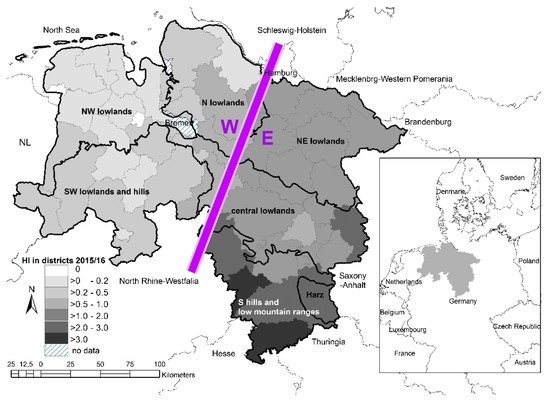
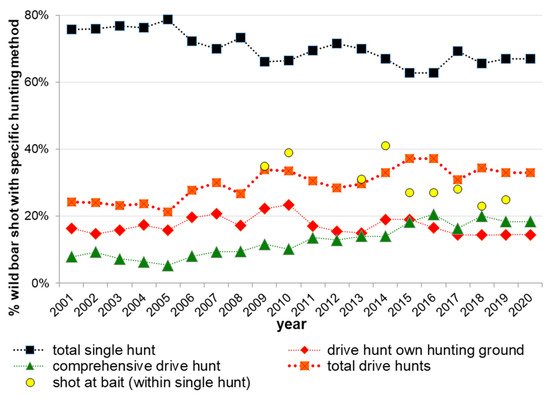

| Hunting Method | Variable | Estimate | SE | p | R2 | F |
|---|---|---|---|---|---|---|
| Total single hunt | Intercept | 13.6851 | 2.3321 | 1.48 × 10−5 | 0.6326 | (1.18) = 30.99 |
| Year | −0.0065 | 0.0012 | 2.77 × 10−0.5 | |||
| Shot at bait (within single hunt) | Intercept | 28.8145 | 8.9892 | 0.0150 | 0.5896 | (1.7) = 10.06 |
| Year | −0.0142 | 0.0045 | 0.0157 | |||
| Total drive hunts | Intercept | −12.6370 | 2.2829 | 2.96 × 10−5 | 0.6407 | (1.18) = 32.1 |
| Year | 0.0064 | 0.0011 | 2.25 × 10−5 | |||
| Drive hunt in own hunting ground | Intercept | 2.4215 | 2.0680 | 0.257 | 0.0617 | (1.18) = 1.184 |
| Year | −0.0011 | 0.0010 | 0.291 | |||
| Comprehensive drive hunts | Intercept | −15.30 | 1.533 | 9.20 × 10−9 | 0.8491 | (1.18) = 101.2 |
| Year | 7.671 × 10−3 | 7.624 × 10−4 | 8.12 × 10−9 |
| Hunting Method | df | p | x2 |
|---|---|---|---|
| Single hunt at bait | 5 | <0.001 | 1492.0 |
| Single hut within fields | 5 | <0.001 | 830.0 |
| Accidential at hunt for other game from hide | 5 | <0.001 | 125.3 |
| stalking | 5 | <0.001 | 115.3 |
| Collective hide | 5 | <0.001 | 113.9 |
| Drive hunt within own hunting ground | 5 | <0.001 | 1317.5 |
| Comprehensive drive hunt | 5 | <0.001 | 1179.8 |
| Selective wild boar drives | 5 | <0.001 | 144.7 |
| During harvest | 5 | <0.001 | 189.8 |
| Small game drive hunt | 5 | <0.001 | 364.2 |
2.2. How to Hunt?
2.2.1. Do You Bait Wild Boar in Your Hunting Ground?
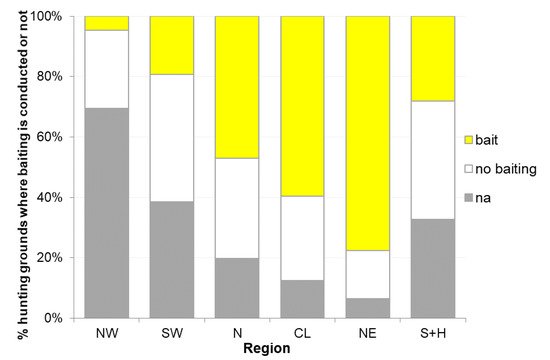
2.2.2. Do You Conduct Drive Hunts on Wild Boar?
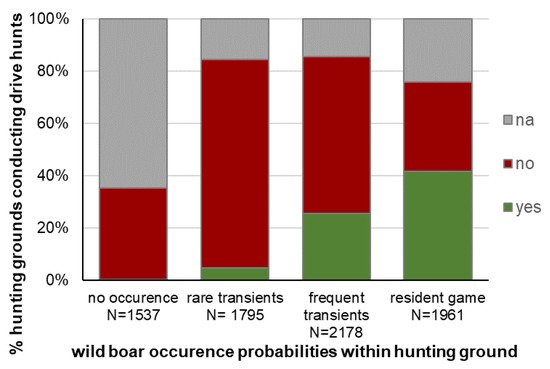
2.2.3. On the Drive Hunts You Conduct: Wild Boar Is (A) Main Species or (B) Incidental Species (“Bycatch”)? Which Other Game Species Are Hunted?
2.2.4. How Do You Conduct Drive Hunts?
- (a)
-
conduction “hunting method”
- (b)
-
hunting party
- (c)
-
type of stands*
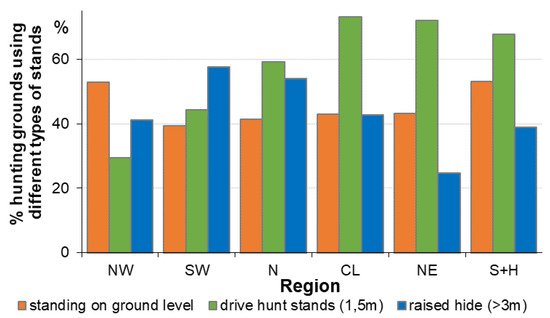
2.2.5. Do You Have Any Difficulties in Conducting Drive Hunts? Which Are These?
3. Current Insights
This entry is adapted from the peer-reviewed paper 10.3390/ani11092658
References
- Keuling, O.; Baubet, E.; Duscher, A.; Ebert, C.; Fischer, C.; Monaco, A.; Podgórski, T.; Prevot, C.; Ronnenberg, K.; Sodeikat, G.; et al. Mortality rates of wild boar Sus scrofa L. in central Europe. Eur. J. Wildl. Res. 2013, 59, 805–814.
- Massei, G.; Kindberg, J.; Licoppe, A.; Gačić, D.; Šprem, N.; Kamler, J.; Baubet, E.; Hohmann, U.; Monaco, A.; Ozoliņš, J.; et al. Wild boar populations up, numbers of hunters down? A review of trends and implications for Europe. Pest Manag. Sci. 2015, 71, 492–500.
- Gortázar, C.; Ferroglio, E.; Höfle, U.; Frölich, K.; Vicente, J. Diseases shared between wildlife and livestock: A European perspective. Eur. J. Wildl. Res. 2007, 53, 241–256.
- Schley, L.; Dufrêne, M.; Krier, A.; Frantz, A.C. Patterns of crop damage by wild boar (Sus scrofa) in Luxembourg over a 10-year period. Eur. J. Wildl. Res. 2008, 54, 589–599.
- Goedbloed, D.J.; Van Hooft, P.; Megens, H.-J.; Bosch, T.; Lutz, W.; Van Wieren, S.E.; Ydenberg, R.C.; Prins, H.H.T. Host genetic heterozygosity and age are important determinants of porcine circovirus type 2 disease prevalence in European wild boar. Eur. J. Wildl. Res. 2014, 60, 803–810.
- Sakurai, R.; Jacobson, S.; Ueda, G. Public Perceptions of Significant Wildlife in Hyogo, Japan. Hum. Dimens. Wildl. 2014, 19, 88–95.
- Frackowiak, W.; Gorczyca, S.; Merta, D.; Wojciuch-Ploskonka, M. Factors affecting the level of damage by wild boar in farmland in north-eastern Poland. Pest Manag. Sci. 2013, 69, 362–366.
- Lagos, L.; Picos, J.; Valero, E. Temporal pattern of wild ungulate-related traffic accidents in northwest Spain. Eur. J. Wildl. Res. 2012, 58, 661–668.
- Frauendorf, M.; Gethöffer, F.; Siebert, U.; Keuling, O. The influence of environmental and physiological factors on the litter size of wild boar (Sus scrofa) in an agriculture dominated area in Germany. Sci. Total Environ. 2016, 541, 877–882.
- Briedermann, L.; Dittrich, G.; Goretzki, J.; Stubbe, C.; Horstmann, H.-D.; Schreiber, R.; Klier, E.; Siefke, A.; Mehlitz, S. Ent-wicklung der Schalenwildbestände in der DDR und Möglichkeiten der Bestandsregulierung. Beitr. Jagd-und Wildforschung 1986, 14, 16–32.
- Massei, G.; Cowan, D. Fertility control to mitigate human–wildlife conflicts: A review. Wildl. Res. 2014, 41, 1–21.
- Massei, G.; Roy, S.; Bunting, R. Too many hogs? A review of methods to mitigate impact by wild boar and feral hogs. Hum. Wildl. Interact. 2011, 5, 79–99.
- Vetter, S.G.; Ruf, T.; Bieber, C.; Arnold, W. What Is a Mild Winter? Regional Differences in Within-Species Responses to Climate Change. PLoS ONE 2015, 10, e0132178.
- Tolon, V.; Dray, S.; Loison, A.; Zeileis, A.; Fischer, C.; Baubet, E. Responding to spatial and temporal variations in predation risk: Space use of a game species in a changing landscape of fear. Can. J. Zool. 2009, 87, 1129–1137.
- Keuling, O.; Nahlik, A.; Fonseca, C. Wild boar research—A never ending story? Wildl. Biol. Pract. 2014, 10, i–ii.
- Ballari, S.A.; Barrios-García, M.N. A review of wild boar Sus scrofa diet and factors affecting food selection in native and introduced ranges. Mammal Rev. 2014, 44, 124–134.
- Briedermann, L. Schwarzwild, 3rd ed.; Franckh-Kosmos GmbH & Co., KG: Stuttgart, Germany, 2009; p. 596.
- Morelle, K.; Podgórski, T.; Prévot, C.; Keuling, O.; Lehaire, F.; Lejeune, P. Towards understanding wild boar Sus scrofa movement: A synthetic movement ecology approach. Mammal Rev. 2015, 45, 15–29.
- Segura, A.; Acevedo, P.; Rodríguez, O.; Naves, J.; Obeso, J.R. Biotic and abiotic factors modulating wild boar relative abundance in Atlantic Spain. Eur. J. Wildl. Res. 2014, 60, 469–476.
- Prévot, C.; Licoppe, A. Comparing red deer (Cervus elaphus L.) and wild boar (Sus scrofa L.) dispersal patterns in southern Belgium. Eur. J. Wildl. Res. 2013, 59, 795–803.
- Keuling, O.; Lauterbach, K.; Stier, N.; Roth, M. Hunter feedback of individually marked wild boar Sus scrofa L.: Dispersal and efficiency of hunting in northeastern Germany. Eur. J. Wildl. Res. 2010, 56, 159–167.
- Podgórski, T.; Lusseau, D.; Scandura, M.; Sönnichsen, L.; Jędrzejewska, B. Long-Lasting, Kin-Directed Female Interactions in a Spatially Structured Wild Boar Social Network. PLoS ONE 2014, 9, e99875.
- Glikman, J.A.; Frank, B. Human Dimensions of Wildlife in Europe: The Italian Way. Hum. Dimens. Wildl. 2011, 16, 368–377.
- Treves, A.; Wallace, R.B.; Naughton-Treves, L.; Morales, A. Co-Managing Human–Wildlife Conflicts: A Review. Hum. Dimens. Wildl. 2006, 11, 383–396.
- Keuling, O. Human dimension in wild boar management. In Proceedings of the 31st IUGB Congress, Brussels, Belgium, 27–29 August 2013; p. 74.
- von Essen, E. How Wild Boar Hunting Is Becoming a Battleground. Leis. Sci. 2019, 42, 552–569.
- Keuling, O.; Strauß, E.; Siebert, U. Regulating wild boar populations is somebody else’s problem! Human dimension in wild boar management. Sci. Total Environ. 2016, 554–555, 311–319.
- Saito, M.; Momose, H.; Mihira, T. Both environmental factors and countermeasures affect wild boar damage to rice paddies in Boso Peninsula, Japan. Crop. Prot. 2011, 30, 1048–1054.
- Ueda, G.; Kanzaki, N.; Koganezawa, M. Changes in the Structure of the Japanese Hunter Population from 1965 to 2005. Hum. Dimens. Wildl. 2010, 15, 16–26.
- Frank, B.; Mónaco, A.; Bath, A.J. Beyond standard wildlife management: A pathway to encompass human dimension findings in wild boar management. Eur. J. Wildl. Res. 2015, 61, 723–730.
- Sabrina, S.; Jean-Michel, G.; Carole, T.; Serge, B.; Eric, B. Pulsed resources and climate-induced variation in the reproductive traits of wild boar under high hunting pressure. J. Anim. Ecol. 2009, 78, 1278–1290.
- Servanty, S.; Gaillard, J.-M.; Ronchi, F.; Focardi, S.; Baubet, E.; Gimenez, O. Influence of harvesting pressure on demographic tactics: Implications for wildlife management. J. Appl. Ecol. 2011, 48, 835–843.
- Gethöffer, F.; Sodeikat, G.; Pohlmeyer, K. Reproductive parameters of wild boar (Sus scrofa) in three different parts of Germany. Eur. J. Wildl. Res. 2007, 53, 287–297.
- Cellina, S. Effects of Supplemental Feeding on the Body Condition and Reproductive State of Wild Boar Sus scrofa in Luxembourg. Ph.D. Thesis, University of Sussex, Sussex, UK, 2008.
- Bieber, C.; Ruf, T. Population dynamics in wild boar Sus scrofa: Ecology, elasticity of growth rate and implications for the management of pulsed resource consumers. J. Appl. Ecol. 2005, 42, 1203–1213.
- Servanty, S. Dynamique d´une Population Chassée de Sanglier (Sus scrofa scrofa) en Milieu Forestier. Ph.D. Thesis, Univerité Claude Bernard, Lyon, France, 2008.
- Servanty, S.; Gaillard, J.-M.; Togo, C.; Lebreton, J.-D.; Baubet, E.; Klein, F. Population management based on incomplete data: Modelling the case of wild boar (Sus scrofa scrofa) in France. In Proceedings of the XXVII Congress of IUGB, Hanover, Germany, 28 August–3 September 2005; pp. 256–257.
- Sodeikat, G.; Papendiek, J.; Richter, O.; Söndgerath, D.; Pohlmeyer, K. Modelling population dynamics of wild boar (Sus scrofa) in Lower Saxony, Germany. In Proceedings of the XXVII Congress of IUGB, Hanover, Germany, 28 August–3 September 2005; pp. 488–489.
- Caley, P.; Ottley, B. The Effectiveness of Hunting Dogs for Removing Feral Pigs (Sus Scrofa). Wildl. Res. 1995, 22, 147–154.
- Dexter, N. The Effect of an Intensive Shooting Exercise from a Helicopter on the Behaviour of Surviving Feral Pigs. Wildl. Res. 1996, 23, 435–441.
- Engeman, R.; Hershberger, T.; Orzell, S.; Felix, R.; Killian, G.; Woolard, J.; Cornman, J.; Romano, D.; Huddleston, C.; Zimmerman, P.; et al. Impacts from control operations on a recreationally hunted feral swine population at a large military installation in Florida. Environ. Sci. Pollut. Res. 2014, 21, 7689–7697.
- McIllroy, J.C.; Saillard, R.J. The effect of hunting with dogs on the numbers and movements of feral pigs, Sus scrofa, and the subsequent success of poisoning exercises in Namadgi National Park, A.C.T. Wildl. Res. 1989, 16, 353–363.
- Marsan, A.; Spanò, S.; Tognoni, C. Management attempts of wild boar (Sus scrofa L.): First results and outstanding researches in Northern Apennines (Italy). IBEX J. Mt. Ecol. 1995, 3, 219–221.
- Mazzoni della Stella, R.; Calvoi, F.; Burrini, L. The wild boar management in a province of Central Italy. IBEX J. Mt. Ecol. 1995, 3, 213–216.
- Mazzoni della Stella, R.; Calvoi, F.; Burrini, L. Wild boar management in an area of southern Tuscany (Italy). IBEX J. Mt. Ecol. 1995, 3, 217–218.
- Fruziński, B.; Łabudzki, L. Management of wild boar in Poland. Eur. J. Wildl. Res. 2002, 48, 201–207.
- Alexandrov, T.; Kamenov, P.; Stefanov, D.; Depner, K. Trapping as an alternative method of eradicating classical swine fever in a wild boar population in Bulgaria. Rev. Sci. Tech. OIE 2011, 30, 911–916.
- Geisser, H.; Reyer, H.-U. Efficacy of hunting, feeding, and fencing to reduce crop damage by wild boars. J. Wildl. Manag. 2004, 68, 939–946.
- Briedermann, L. Jagdmethoden beim Schwarzwild und ihre Effektivität. Beitr. Jagd-und Wildforschung 1977, 10, 139–152.
- Braga, C.; Alexandre, N.; Fernandez-Llário, P.; Santos, P. Wild boar (Sus scrofa) harvesting using the espera hunting method: Side effects and management implications. Eur. J. Wildl. Res. 2010, 56, 465–469.
- Keuling, O.; Stier, N.; Roth, M. How does hunting influence activity and spatial usage in wild boar Sus scrofa L.? Eur. J. Wildl. Res. 2008, 54, 729–737.
- Sodeikat, G.; Pohlmeyer, K. Escape movements of family groups of wild boar Sus scrofa influenced by drive hunts in Lower Saxony, Germany. Wildl. Biol. 2003, 9, 43–49.
- Sodeikat, G.; Pohlmeyer, K. Impact of drive hunts on daytime resting site areas of wild boar family groups (Sus scrofa L.). Wildl. Biol. Pract. 2007, 3, 28–38.
- Scillitani, L.; Monaco, A.; Toso, S. Do intensive drive hunts affect wild boar (Sus scrofa) spatial behaviour in Italy? Some evidences and management implications. Eur. J. Wildl. Res. 2010, 56, 307–318.
- Maillard, D.; Fournier, P. Effect of shooting with hounds on home range size of Wild Boar (Sus scrofa L.) groups in Mediter-ranean habitat. IBEX J. Mt. Ecol. 1995, 3, 102–107.
- Thurfjell, H.; Spong, G.; Ericsson, G. Effects of hunting on wild boar (Sus scrofa L.) behaviour. Wildl. Biol. 2013, 19, 87–93.
- Elliger, A.; Linderoth, P.; Pegel, M.; Seitler, S. Ergebnisse einer landesweiten Befragung zur Schwarzwildbewirtschaftung. WFS-Mitteilungen 2001, 5, 5–7.
- Liebl, T.; Elliger, A.; Linderoth, P. Aufwand und Erfolg der Schwarzwildjagd in einem stadtnahen Gebiet. WFS-Mitteilungen 2005, 9, 1–5.
- Quirós-Fernández, F.; Marcos, J.; Acevedo, P.; Gortázar, C. Hunters serving the ecosystem: The contribution of recreational hunting to wild boar population control. Eur. J. Wildl. Res. 2017, 63, 57.
- Monzón, A.; Bento, P. An analysis of the hunting pressure on wild boar (Sus scrofa) in the Trás-os-Montes region of Northern Portugal. Galemys 2004, 16, 253–262.
- Tsachalidis, E.P.; Hadjisterkotis, E. Wild boar hunting and socioeconomic trends in Northern Greece, 1993–2002. Eur. J. Wildl. Res. 2008, 54, 643–649.
- Luskin, M.; Christina, E.D.; Kelley, L.C.; Potts, M.D. Modern Hunting Practices and Wild Meat Trade in the Oil Palm Plantation-Dominated Landscapes of Sumatra, Indonesia. Hum. Ecol. 2013, 42, 35–45.
- Boumendjel, F.Z.; Hajji, G.E.M.; Valqui, J.; Bouslama, Z. The Hunting Trends of Wild Boar (Sus scrofa) Hunters in Northeastern Algeria. Wildl. Biol. Pract. 2017, 12.
- Da Rosa, C.A.; Wallau, M.O.; Pedrosa, F. Hunting as the main technique used to control wild pigs in Brazil. Wildl. Soc. Bull. 2018, 42, 111–118.
- Ueda, G.; Kanzaki, N. Wild Boar Hunters Profile in Shimane Prefecture, Western Japan. Wildl. Biol. Pract. 2005, 1, 146–151.
- Keuling, O.; Stier, N.; Roth, M. Annual and seasonal space use of different age classes of female wild boar Sus scrofa L. Eur. J. Wildl. Res. 2008, 54, 403–412.
- Saito, M.; Koike, F.; Momose, H.; Mihira, T.; Uematsu, S.; Ohtani, T.; Sekiyama, K. Forecasting the range expansion of a re-colonising wild boar Sus scrofa population. Wildl. Biol. 2012, 18, 383–392.
- Blumstein, D.T.; Berger-Tal, O. Understanding sensory mechanisms to develop effective conservation and management tools. Curr. Opin. Behav. Sci. 2015, 6, 13–18.
- Toïgo, C.; Servanty, S.; Gaillard, J.M.; Brandt, S.; Baubet, E. Disentangling natural fom hunting mortality in an intensively hunted wild boar population. J. Wildl. Manag. 2008, 72, 1532–1539.
- Milner, J.M.; Bonenfant, C.; Mysterud, A.; Gaillard, J.-M.; Csányi, S.; Stenseth, N.C. Temporal and spatial development of red deer harvesting in Europe: Biological and cultural factors. J. Appl. Ecol. 2006, 43, 721–734.
- Vajas, P. Évaluation des Facteurs Influençant le Succès de la Chasse pour Gérer le Sanglier (Sus scrofa): Comprendre les Relations entre l’Effort de Chasse, la Capturabilité et les Conditions de Chasse. Ph.D. Thesis, Université de Montpellier, Montpellier, France, 2020.
- Keuling, O.; Greiser, G.; Grauer, A.; Strauß, E.; Bartel-Steinbach, M.; Klein, R.; Wenzelides, L.; Winter, A. The German wildlife information system (WILD): Population densities and den use of red foxes (Vulpes vulpes) and badgers (Meles meles) during 2003–2007 in Germany. Eur. J. Wildl. Res. 2010, 57, 95–105.
- Tillmann, J.E.; Beyerbach, M.; Strauss, E. Do hunters tell the truth? Evaluation of hunters’ spring pair density estimates of the grey partridge Perdix perdix. Wildl. Biol. 2012, 18, 113–120.
- Strauß, E.; Grauer, A.; Bartel, M.; Klein, R.; Wenzelides, L.; Greiser, G.; Muchin, A.; Nösel, H.; Winter, A. The German wildlife information system: Population densities and development of European Hare (Lepus europaeus PALLAS) during 2002–2005 in Germany. Eur. J. Wildl. Res. 2007, 54, 142–147.
